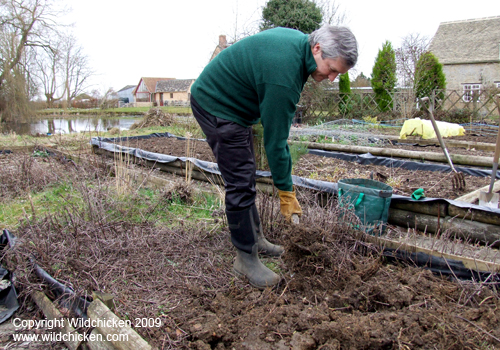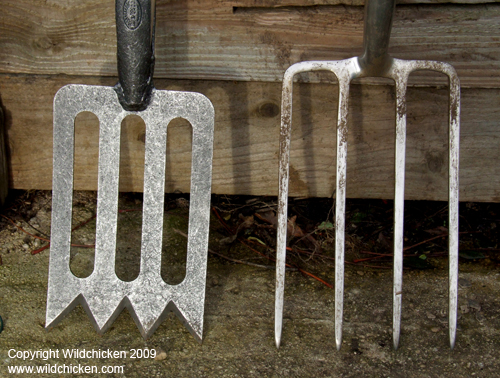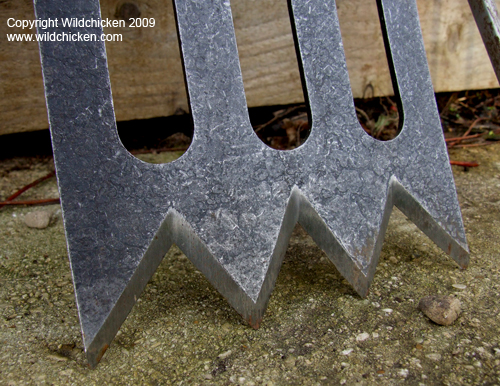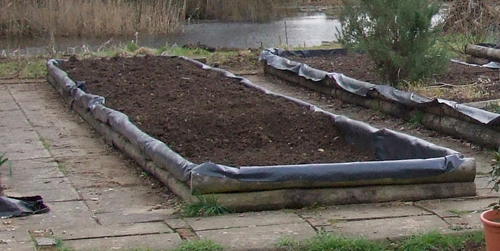Trialling the digging Spork -
We try out the Spork, a new tool that combines both fork and spade in a simple, efficient design.

Of the five 11m long raised beds at our new garden, we’d prepared all but one. Still left to do was the bed that we’d been avoiding, the mint bed. The mint bed had potential, 11m long and 1.5m wide it was too much good space to waste but some 10 years ago, someone had put in two or three little mint plants and my, had they done well. They’d thrived, growing to fill almost half the length of the bed and all of the width. Where there wasn’t mint, there was thick grass, raspberries and brambles and it all had to come out. On top of that, some of the wooden edging boards had fallen off and much of the plastic lining was shredded.
‘We must tackle the mint bed’, we’d say and agree that it really had to be done, as soon as possible, if it was to be ready for planting. Then we’d go over to it and sigh and suddenly realise that there were other jobs that needed to be done first - lots of them, in fact. It happened again and again. We would look at the mint bed, and think ‘Oh, let's do it later’, slink away and try not to think about it.

Mint
The moment arrived when something had to be done and we started by cutting everything down to ground level which made it look slightly less awful and then started trying to dig out the mint with a fork. Trying to wrench out the mass of growth with a fork was going to take forever, so we tried a spade, but it was nowhere near sharp enough. Then we slapped our foreheads and remembered a tool that we’d been given to try a few weeks back and which should be just the ticket for a job like this – the Spork.
Sporks are half spade, half fork, like a giant version of the runcible spoon, only used for digging rather than eating. We got it out and gave it a go and it worked like a dream, slicing through the dense mat of roots and stems with surprising ease and we began to think that the bed might be useable this year, after all. Using it to cut through the congested mint growth made the job mercifully easier than we’d anticipated and we got the whole bed cleared and rebuilt in a couple of days.

Karl using the Spork - note the discarded spade and fork in the next bed
The Spork is a flat-bladed tool with cut-outs on the ‘spade’ part of it which make it lighter and stop the building up lumps of soil on the blade. The serrated end of the blade is cut into four sharp teeth and as the blade is made of steel, these can be sharpened to keep the tool in top condition. The handle is made of oiled Ash and comes with either a D or a T handle.

Spork and fork
You can also use Sporks for general digging, riddling through soil, edging lawns and border edges and for skimming off surface weeds before digging over a new bed. It’s also useful for dividing large clumps of perennials, which can be tough to get through with spades.
Sporks are available by mail order from Complete Gardens Ltd
Miranda's verdict
For myself, I found it to be a great tool and an excellent addition to the tool shed.
I found that the relatively narrow blade is good for going through clay, as you don’t pick up as much as with a wider-bladed conventional fork or spade, which can make it too heavy. This makes it an especially good tool for women – and as more women are taking on allotments and vegetable gardens these days, I can see that it would be a very useful tool. The sharpness of the serrated edge also eases the job of digging through clay, which can be hard work at the best of times.
At £60, it may not be the cheapest, but I'm a firm believer in buying the best tools I can afford and believe that you get what you paid for.
Definitely recommended.

Spork blade teeth

After we'd finished - a bit different
© Copyright Miranda Hodgson 2009